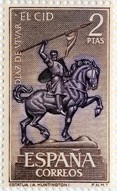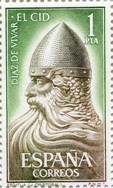Back The legend
Nine centuries after the death of Rodrigo Díaz de Vivar and eight centuries after the legends of his exploits were written down in The Song of My Cid, this important figure continues to be a paradigm of the hero that arouses fascination and constitutes a source of inspiration.

Many of the events and exploits that are attributed to the Cid never happened, but they have helped to establish the myth. The Cid was the hero that the Spanish Christianity of the Middle Ages needed in that historical context: it was the era of the Crusades, the age of the Reconquest and of expansion southwards.
The historic figure that inspired the legend, Rodrigo Díaz de Vivar, was born in the village of Vivar (Burgos) around 1043. He commenced his life as a knight at the end of the reign of Ferdinand I.
He entered the service of one of the king's sons - Sancho II, king of Leon, after whose death he served underAlphonse VI. He married the Leonese noblewoman Jimena Diaz, the daughter of the count of Oviedo, who was descended from the kings of Leon. In 1081, banished into exile after a false accusation of theft, he offered his services to the Muslim rulers of Zaragoza. In 1088 he returned from exile to Castile, subsequently to defeat the king of Aragon and the count of Barcelona. In due course in 1094 he conquered an entire kingdom and became governor of Valencia.

A life that has earned a place in history, literature and the arts.
The Spanish Royal Mint, in deference to this masterpiece of Spanish mediaeval literature, has minted a set of three coins: an 8-reales coin in silver with a denomination of 10 Euros, a silver cincuentin with a denomination of 50 Euros, and a 4-escudo coin in gold with a denomination of 200 Euros.